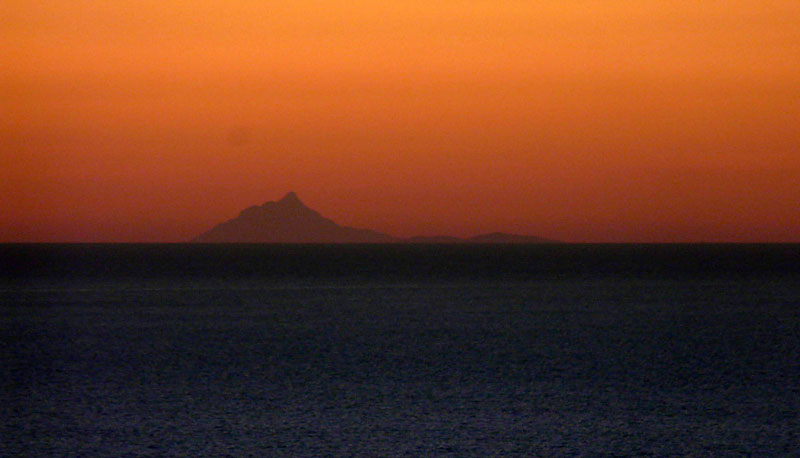At certain times during the spring and autumn, visitors to the north of Lesvos see a mysterious mountain silhouetted against the sunset or just after it has set. It seems to rise up out of the sea, sometimes it looks big and sometimes it looks small. Everyone wants to know what and where is that? Is it Mount Athos, is it Agios Efstratios? We were also puzzled. Mount Athos is 180 km from Molyvos and at 2033 metres high, only the top 12 metres should be visible. This is too small to be seen with the naked eye at this distance. It must be Agios Efstratios!
Then, one evening we were at Byzantino during sunset and saw the mystery mountain. When we got home, I looked up the angle (from north) of the sun at sunset that evening, the answer was 300 degrees. Google earth shows that the angle of Agios Efstratios is 285 degrees and Mount Athos is 300 degrees! So, the mystery mountain must be Mount Athos, but why can we see it and why is it a different size on different days?
The answer to that involves some science, the science of atmospheric refraction to be precise and a lot of complex mathematics. Put simply, the changing density of air at different altitudes causes the light to bend and we don’t ‘see’ in a straight line. With no refraction, only 12 metres of Mount Athos would be visible above the horizon as I had previously calculated. With weak refraction, about 272 metres should be visible but this is only just visible to the naked eye from a distance of 180 km. Standard refraction levels make about 332 metres visible, now we begin to see it. Strong refraction makes 758 metres visible (about one-quarter of its height). Then there are the rare days where refraction is even stronger which give us the spectacular views that so many have seen. On these days it is possible that more than half of Mount Athos is visible. The level of refraction depends upon the air temperature, the humidity and the air pressure. Some days you see it, some days you don’t. Add the fact that it is only obvious on the few days each year that the sun sets very close to or directly behind Mount Athos.

The above picture is by Leen Kool and was taken near Molyvos Castle.
Thank you Leen.
